DANNY BRISBANE FLYNN MORRIS-CLARKE JAMES BELLANEY EMMA CHALMERS ELIOT COATES LINDA COOK JIMMY VARGA JON COX SAM FOLEY MICHAEL GREAVES NICOLA HANSBY HANNAH JOYNT SYLVIE KAOS PHILIP MADILL PIPPI MILLER CHARLOTTE ROBERTSON ANYA SINCLAIR PETE WHEELER NEW DUNEDIN PAINTING (redux)
NEW DUNEDIN PAINTING (redux) DANNY BRISBANE FLYNN MORRIS-CLARKE JAMES BELLANEY EMMA CHALMERS ELIOT COATES LINDA COOK JIMMY VARGA JON COX SAM FOLEY MICHAEL GREAVES NICOLA HANSBY HANNAH JOYNT SYLVIE KAOS PHILIP MADILL PIPPI MILLER CHARLOTTE ROBERTSON ANYA SINCLAIR PETE WHEELER
New Dunedin Painting (redux) is a reimagining of a show facilitated by Flynn Morris-Clarke and Anya Sinclair in 2013 at Brick Brothers Gallery, entitled ‘New Dunedin Painting’. That exhibition featured work by thirteen painters in or with links to Dunedin,* many of whom studied at the Dunedin School of Art. It presented new work from a community of painters with close ties to this city in a demonstration and celebration of painting and the myriad of different approaches at play in the Dunedin painting scene.
New Dunedin Painting (redux) plays off this same theme in 2022, in a continuation of this work and in honour of our friend Flynn Morris-Clarke, and his love of painting. We have brought together work by eighteen artists, many of whom featured in the original exhibition in 2013. With the permission of their families, we also include works by Flynn and Danny; including Flynn’s work Ilish, which featured in the 2013 exhibition and which has kindly been loaned to us by Graham Brentleigh Bond.
We would like to offer our thanks to Flynn and Danny’s families and their contribution to this exhibition, through which we also hope to celebrate the work of Flynn and Danny and to keep their memories alive.
We note that 10% of commission on all sales will be going to a charity of Flynn’s family’s choosing; 10% to a charity of Danny’s family’s choosing; and 10% to contribute to Wave Project Space’s basic costs.
Thanks again so much to Flynn and Danny’s family and friends who have facilitated the inclusion of their works in this show; to those who have included texts in the catalogue; and to all the artists who have contributed to this project.
Kari Schmidt & Michael Greaves
*Including Greg Lewis, Nicola Hansby, Philip Madill, Eliot Coates, Anya Sinclair, Philip J Frost, James Bellaney, Emma Chalmers, Michael Greaves, Jasmine Middlebrook, Craig Freeborn, Flynn Morris-Clarke and Danny Brisbane.
4
Curators’ foreword
1 Foreword Leoni Schmidt*
New Dunedin Painting (redux)
@ Wave Project Space 2022
Dunedin has been a place for painters for a long time. Early Māori rock paintings can be seen at Takiroa near Duntroon north of Dunedin, dating several hundreds of years ago. Nearer to our time, famous New Zealand artists such as Ralph Hotere, Colin McCahon, and Frances Hodgkins worked in Dunedin and today some of their work can be seen in the Dunedin Art Gallery alongside early European painterly depictions of Māori, such as those by Goldie and Lindauer. Together with the early artists, this gallery and its collections fostered a love of painting within the Dunedin community as did the Hocken Collections, many commercial galleries, the street painting initiative in the city, and art teaching in a city whose very existence is underpinned by education.
The Dunedin School of Art at Otago Polytechnic has played a major role in the sustainability of painting in our city over the decades since 1870. Founded by Scottish painter David Con Hutton, it became a haven for art students and art tutors, with painting being a core studio in the curriculum up to this day. Many painting tutors, such as R.N. Field and Girolamo Nerli, joined the school from England and Europe and brought modernist ideas and studio methods with them. These tutors never fostered a house style and the freedom afforded students became on ongoing feature of painting outputs. The eclectic nature of the current show still reflects this approach. In more recent times, studio lecturers such as Lynn Plummer in the 1990s, Clive Humphreys, Graham Fletcher, Michael Greaves, Anita DeSoto, and Michael Morley in the 2000s brought their own energy and approaches to the painting studio, thereby enriching the creative environment for students.
Wave Project Space invited eighteen artists to participate in New Dunedin Painting 2022, most of whom studied at the Dunedin School of Art. The salon hang in the gallery reflects its non-hierachical approach as a not-for-profit arts space aiming for inclusivity and equality. What does stand out though, is the rememberance of two Dunedin painters who are no longer with us.
Danny Brisbane studied with the Dunedin School of Art in 2010-2011, leaving at the end of his second year. Artist and painting lecturer Michael Greaves writes in an email to me: “He was a curious and interesting student, with a lot to give. He was kind, funny and a larger than life presence in the studio, serious about his pathway as
an artist in all forms and states. Danny’s work was a look into the outsider, the shaman and the downtrodden, his work – delicate pencil sketches or robust oils on burlap – held the viewer in a kind of time traveller’s state of disbelief, [represented by] a mustachioed cowboy or ‘other’. He was interested in Richard Avedon’s front-on portraits of iconic figures. Danny weaved these into a local mash up of characters of his life and times, a pirate twist on the interconnected nature of the human spirit.” His work speaks of improvisation, a creative grab of images that come to hand, a bricolage of ideas without too much control: in one work an Elvis look-alike, a car crash, shoes, First Nations people, animals, small objects and monuments. The canvas becomes a terrain for capturing ideas and memories, a page in a sketch book. This improvisational quality of Danny’s painting likens it to the provisional nature of drawing: fast, loose, never finished, on its way to becoming something else, reaching out to the next step. One work on show at Wave, however, presents another aspect of Danny’s practice: the portrait as a conveyor of inner states of being, in this case suggesting turmoil and anxiety through distortion of form, heavy impasto texture, and saturated colour contrast.
Flynn Morris-Clarke enrolled for a Master of Visual Arts at the Dunedin School of Art some years ago. I was assigned as supervisor for his writing alongside Neil Emmerson as his studio supervisor. Supervising the writing component of his postgraduate study involved many ongoing discussions around his arts practice, its contemporary context, its historical antecedents, how it could depict the strange life of celebrities (real or imagined), about ideas and experiences and how these related to his studio work. Flynn had an unquenchanable thirst for knowledge and understanding: it mattered to him to know about his paintings and where they fit into our world. He was never satisfied and continued to question me and others: one answer would not suffice. Flynn was on a mission and he was energised and impatient to get there. I understand that he created around 400 paintings.
Flynn gave me one of his paintings, in my view his best work and very similar to the self-portrait on this show, a small work in watercolour. It hangs in my house, at my front door, the first thing any visitor can see. Its been there for some years now. After Flynn completed his postgraduate study, i was happy to see it as a daily affirmation of his success. When Flynn became ill, I waved at it in the mornings on my way out, as if to say, ‘take care’. Now, I look at it with tears and regret at Flynn’s passing. However, the painting invites me to remember complex Flynn through his work: The painting is vividly alive, it pulsates with energy and verve. One can imagine Flynn in his studio, making this painting in one go – watercolour does not allow for slow work. Through orange, pink,
2
ultramarine and self-confident brushstrokes, the work says: “... here i am, myself as I am, alive and loving it”, but there is also an indigo and black darkness pooled in the dried paint, an experience of life’s sorrows and pain.
Flynn was a spontaneous and generous soul: why else such an extraordinary gift handed over in an impetuous moment of mutual understanding and camaraderie? He could also laugh at himself, happily acknowledging that writing was not his strong suit and being grateful for my help. And, i remember fondly his joy in welcoming me and Neil to his studio, his exuberance in showing us new works in the making, impatiently waiting for our comments. There was pain and sorrow. And there was passionate, joyful, spontaneous, generous, funny, brilliant Flynn – we miss you. Kia kaha Scott and Barbara and Mary and Greer and family. Here at Wave, your boy and brother again lives on through his work in an exhibition dedicated to him and Danny.
“Paintings have a life of their own...” wrote Vincent van Gogh in the late-nineteenth century and roughly a century later, Frank Stella said: “One learns about painting by looking at [the work] of other painters.” The other sixteen painters represented in this exhibition at Wave each bring a different visual and iconographic language to the mix, each work shows us its ‘own life’ and at the same time they resonate with the work of those who came before. As mentioned earlier, most of the painters studied at the Dunedin School of Art, where they would have been immersed in art history and theory and thus echoes of practices past are very much present in their work. Within the confines of this text, a few notes about each work on exhibition are presented on the fllowing page as prompts* for further discussion amongst viewers of the exhibition.
* To the artists: My apologies if you don’t agree with the prompts, art works exhibited in the public domain invite responses and mine will only be some amongst many other, different ones.
* Professor Leoni Schmidt is currently the Director: Research & Postgraduate Studies at Otago Polytechnic and the DCE: Academic for the OP Auckland International Campus. With a fine arts and art history & theory background, she was the Head: Dunedin School of Art from 2009-2017 and continues to be a writer on contemporary visual arts practice..
3
James Bellaney: A robust painterly, dark and apocalyptic take on the sublime experience of the Aotearoa New Zealand landscape with reminiscences of Petrus van de Velde’s iconic roaring rivers and vertical rockscapes.
Emma Chalmers: Romulus and Remo, but this lonely she-wolf seems to have lost her human twins while she inhabits the outer edge of the page – a broken relationship and a severed bond between the human and the more-than-human?
Eliot Coates: A vertical field of luminosity offset by one subtle horizontal counterpoint, Colour Field painting made new for us to lose ourselves in meditation, wrapped around in warmth and stillness, quietude.
Linda Cook: Intermaterialities, painting meets ceramics, the joy in tactility becomes an end in itself, why should sight be the privileged sense? One remembers Antoni Tàpies and Jean Dubuffet, art brut, l’art informel.
Jon Cox: An abstract painting which is at the same time a celebration of clay and a reference to the vibrant colours of India and the ornamental tracery of Muslim architecture and decoration, intercultural travel.
Sam Foley: A landscape in Aotearoa New Zealand’s pictorial tradition but this time transcended as a darkness and directional confusion overtakes the wanderer in the lush environment, and where the path leads to is uncertain.
Michael Greaves: Mark Rothko turned sideways and overlaid with a mist of white vapour obscuring what lies beneath, painting joyfully playing between being a representation, a reference, a thing, and a window.
Nicola Hansby: Oh joy of painting, shock of rose on red! Henri Matisse in a new guise and a nod to Giorgio Morandi in the mix of the artist’s own take on the simplicity of the painted cut-out. One lingers as a memory cannot suffice.
Hannah Joynt: A distinct visual language, ordinary people going about their activities during an agricultural fête, memories of the picaresque tradition in painting, Pieter Bruegel the Elder but with lightness and humour and verve.
Sylvie Kaos: Diverting attention away from the portrait as an endeavour that can only ever (partially) fail, celebrating collage: a core invention of the 20th Century from Picasso to cut-and-paste on our devices.
Philip Madill: Drawing and print landscape infused with the colour of blood and visually tremoring with the shock of war, a soldier laying a bomb, a path that turns a bend with no clear view beyond?
Pippi Miller: Well-known: a figure in a landscape. But this figure is unsettlingly large for their setting, dominating the environment but also looking sideways at who might be calling them out from beyond the frame.
Charlotte Robertson: The healing qualities of plants enframing, of rain descending, of female form enfolding, a reference to the almond-shaped mandorla of Renaissance painting enclosing the most treasured of the treasured.
Anya Sinclair: Decaying flowers, dusty paint, roughness of presentation: a Western paradigm of the gilt-framed still-life turned on its head, vanitas – the transience of lffe –taken a huge step further in bicultural Aotearoa.
James Varga: A surprise: drastically pared back work –exploration of spatial ambiguity in painting , thinking of Sydney artist Margaret Robertson at the Blue Oyster long ago, less is more and a new embodied liminality.
Pete Wheeler: This bird confronts us with its monumental presence, its anger, its here-ness, it brooks no argument, no postponement, it demands action. It is no longer a representation of exotic ‘nature’, it has agency and it demands political eco-agency from us.
4
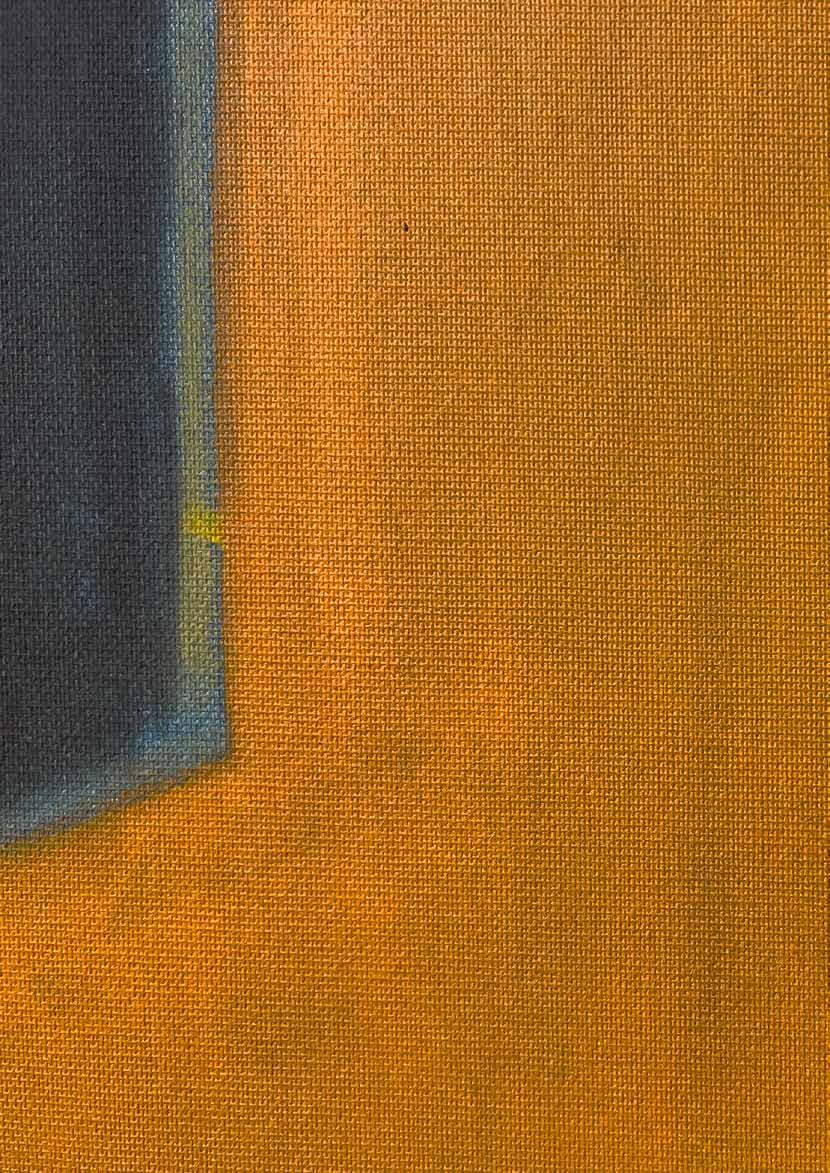


Opposite. Gallery installation shot
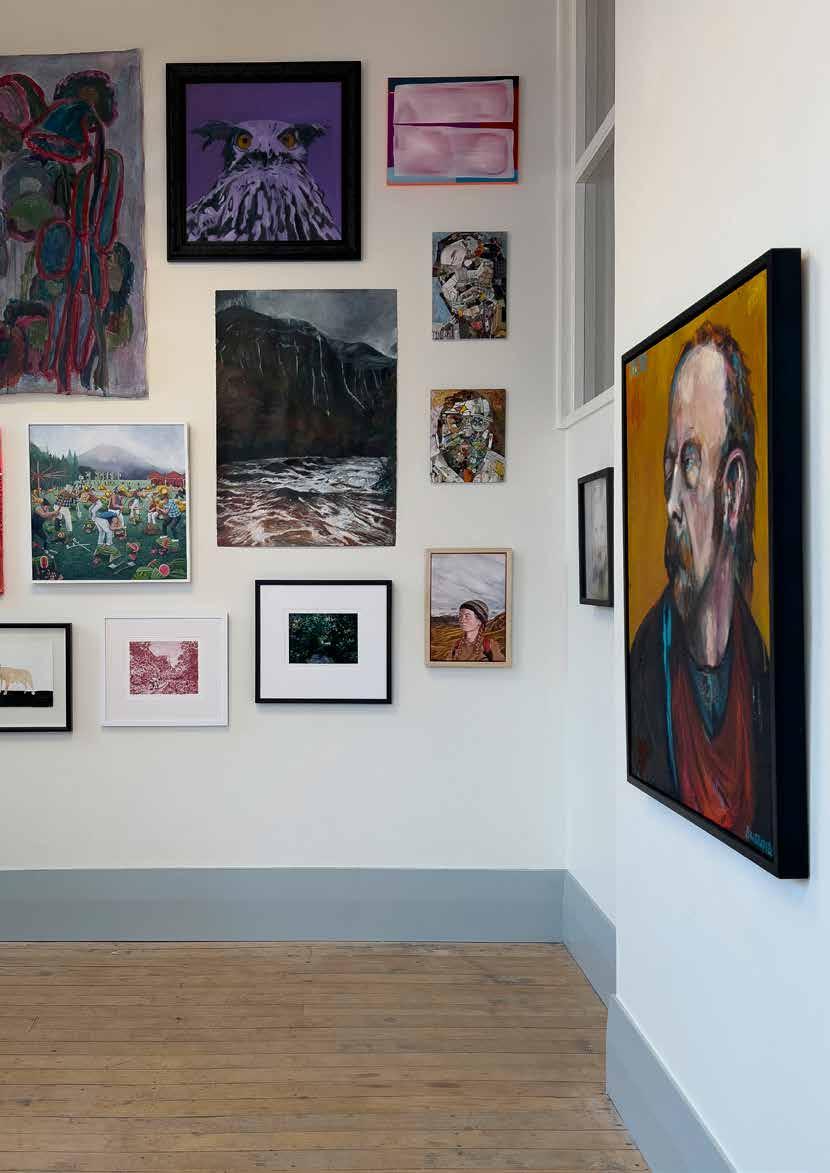
The Painting of Material Life Edward Hanfling
Paintings are redundant objects, really (hear me out); they do not matter much, in the greater scheme of things. But paintings are matter, and matter does matter. More and more matter gets manufactured, thrown out into an already cluttered world. So making paintings better be worthwhile.
The redundancy of painting came about many years ago, when people started doing it for the sake of the pleasure afforded by the materials. And then its complicated relationship to another, more mercantile, materialism became a liability. In reality, though, no other medium can claim to have closed the gap between art and the everyday world. Paintings are as real as anything else. They are redundant because, like anything called “art”, and like much else in the world besides, we do not need them to thrive or survive.
Much has been prattled about the richness art lends to life. But if art were to be summarily banned, one would still have plenty of other things, just as rich, or richer, and just as, or more, artistic, to amuse oneself with – such as test cricket. The real virtue of painting is that it is not too bad. Yes, it can be far from natural or organic in terms of the physical ingredients, which can even be downright toxic. But, overall, it is pretty good harmless fun. Moreover, while there is a recurring chorus of distain for the commodity status of paintings, it is surely mad and wonderful – and just a little bit of a win for the good guys – that money is spent on the owning of them, sometimes far in excess of the materials out of which they were fashioned.
Matter matters now there is a renewed appreciation for what material things do in the world, with or without human beings. Painters have long known about the unruly, supple, whimsical, obstreperous vitality of paint. The “material turn” could be a euphemism for when paint goes bad. Certainly, it is a pushback against the “linguistic turn” of the 1980s-90s, which was when physical stuff became secondary to signifying potential and everything became a human construct. Once upon a time it was all about wringing as many “meanings” as possible out of an artwork. It turns out “the juice aint worth the squeeze” (as Lizzo said about something else), humanity is not the be all and end all, and non-human things and beings act in ways beyond our control.
It is nice, then, to think of painting as a process of collaboration between people and materials. But this carries its own kind of conceit. After all, paint is made by people and painting is a peculiarly human pastime. Anyone who makes a painting does a conventional thing. The beauty of it is that it is also peculiar – unnatural, even. The conventions, of course, are what keep it going as painting rather than something else, sometimes also preventing makers from doing something that matters – something useful, in the popular sense. But when we have done decimating the planet, capitalism having long before imploded, we might feel a little admiration, perhaps even gratitude, toward those oddballs who kept on surprising us with such conventional means and useless stuff in the hope that we might look at the world differently.
Young Hubris. [Portrait of Donald Trump aged 5], Oil on canvas 45cm x 40cm
9
2017
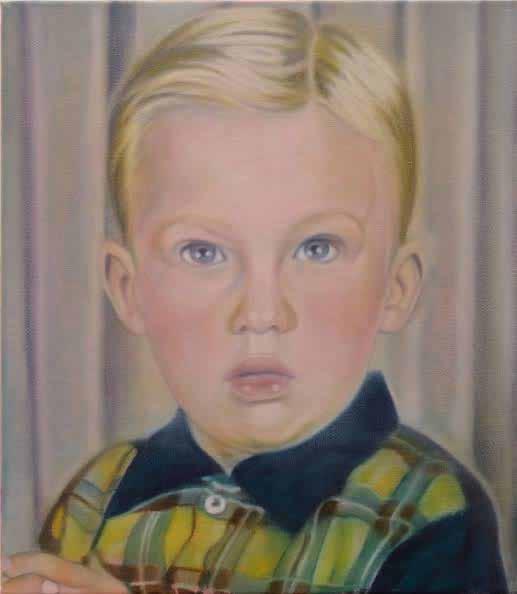
10
BRISBANE
It’s hard to put into words the level of vision Danny had with a brush or pencil in hand. If Danny looked at you for half a minute he could draw you like a photograph the next day from memory. He was able to do this from the age of about five but his artistic vision began at an earlier age. As a toddler Danny began drawing cartoons and faces of people he would meet, and of course as many young boys do he would draw inventions, things only a witty young man could think up. Most famously among his peers, the ‘Le peniscope’ a device he drew that aided larger older men in the ability to see their more private areas without moving their gut. Many have draft copies of the ‘Le peniscope’ on their wall today. This was just a taste of the Danny we would come to know and love.
Stoic in nature only those close to Danny ever heard him speak of his soft side. However anyone who looked at his art would see the huge, gentle and caring heart he had inside. He could capture a flowers beauty and delicate form with ease, and would often add notes to his work that would give an insight to who he was as a person and the things that were happening for him in his mind at the moment, creating a real attachment for the viewer as you create your own feelings around the perfectly imperfect scrawled phrases and lyrics.
Danny would draw old cowboys and bikers, giving them pathos and aura, more heightend than could be captured in photographs. These outlaws and loners, mostly male, became a common subject for him. In five minutes he could make the most detailed drawing of a person you could ever see. The way he captured their eyes still astounds me. He could put a lifetime of pain and vision into an eye with two flicks of his pencil, like he felt it himself, almost like he knew how it was. He would leave hints at what was happening in his life too, from bottle openers to sprigs of particular flowers, drawings of friends he was seeing a lot of at the time. You could see where Danny had been, and who he’d been around by looking at his latest creative work.
While often scarce at his exhibitions, as he liked to let people take his art without his input, the odd occasion he made this known to people who asked maybe one too many questions, but he would always show up looking like a million dollar movie star, often late and on one occasion with a brand new “mum” tattoo. No one meant more to Danny than his family and friends. This was obvious to all who were loved by him.
Danny’s art, to those who knew him, is well a conversation. You can speak to him through his work, and he can speak back, let you know exactly how he feels, and that connection lives on forever. A look into who this incredibly talented man was, and who he is to us all now. He poured his heart out onto the pages, canvases and walls he drew on and now we can cherish them forever. Danny lives on in our hearts in our minds, memories and of course on the page.
Enjoy his work. Look at it and see what you can find for yourself in it. Nothing brought Danny greater joy than these paintings. And we thank him for leaving us touched with these gifts.
A much loved taonga
We love you Danny, always forever. Our brother, our son, our friend. And now our light in the dark.
Complied by Elliot Chilton Philips in conversation with family and friends of Danny.
2022
Danny was a character, warm and gentle, focused and serious. It was this combination that i most recall. I would have wonderful conversations in the studio, trying to tie down his spirit so that it would settle in a place, if only just for a moment, so that his painting would gather the weight and momentum it deserved.
MIchael Greaves
I saw DANNY’s painting before I met him. When I first spent time with him, we played Polka at a friends house in North East Valley. He wore an open pink shirt, tight white T-shirt and a gold chain. He laughed a lot. I couldn’t match him to his painting.
The painting i knew well, because it is incredible; a gnarly old man, hung at Al Bar in Dunedin. Danny’s ability to imbue rich character in his portraits was unrivalled in our painting community. And like Flynn, he often used seductive devices to convey darker themes. Disarming colours, soft pinks, bold reds, dreamlike floating imagery.
I wanted to paint a big pink painting for Danny, for Flynn. It turned out to be mauve. But the message is there. Beauty and death are intertwined.
Above right Cole Younger 1876 Oil on Jute 85cm x 106cm
Below right Untitled Drawing materials on Paper 85cm x 106cm
11 DANNY
2011
2015
September
Anya Sinclair
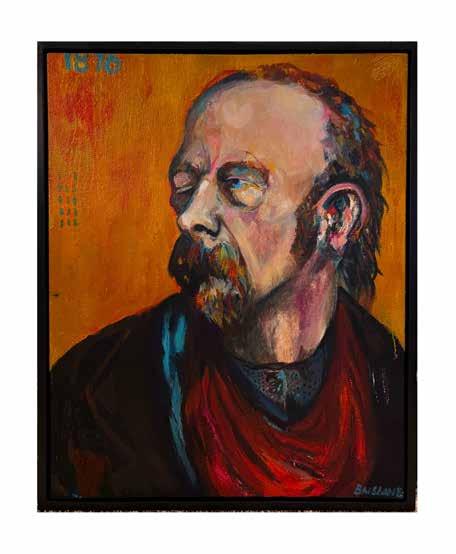
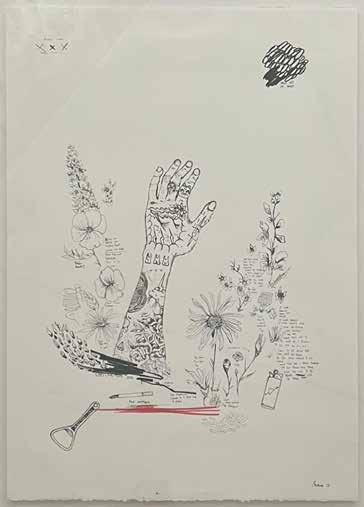
Flynn had a passion for a broad range of artistic experiences, but foremost he had a passion for painting. He understood its unique energy and that at its best its impact is both psychological and visceral. He accepted the condition of painting as both transcendent and flawed. A physical entity of pigment dispersed over the plane canvas or panel, which by some act of magic could morph into a living, breathing, three dimensional experience only to collapse again into a series of material problems with imperfect solutions.
He was infected by the buzz that comes from being a painter, from facing the challenges and frustrations it presents, not least of which the struggle to reconcile an economic reality with an artistic ideal, and from occasionally emerging from its process victorious. My visits to his studio would invariably imbue my own practice with renewed energy and I hope the same was true in return. I miss his passion and heart. He understood what it meant to be an artist and he lived it fully and while I feel his loss personally, I also feel it as a loss to painting itself.
FLYNN and I both worked as dishys at Plato. Occasionally I would bump into him in the street in Dunedin. He wouldn’t hesitate to begin a conversation about painting.
I think about his work now and see how often he presented melancholy and horror through an aesthetically pleasing mask. In my own work I consistently play with this device. I miss our conversations.
I watched his funeral from my bedroom in Port Chalmers. A Purple Pilgrims song was played: Delphiniums in Harmony, Two Worlds Away. It seemed to me to beautifully capture Flynn’s lust for life and the sadness I felt at the loss of him.
Anya Sinclair
Eliot Coates
I met Flynn in about 2003 or 2004 when we were both studying Art Theory and History at the University of Otago, he always came across to me as an intense spirited guy, keen to understand and identify thoughts and concepts about the essence of the painter or the paintings they made.This intensity I feel drove and nourished him in his painted work, and carried him when he was adrift. Later, as a student of mine at the Dunedin School of Art, these concerns were still at the top of his mind. I remember him to be methodically studying David Hockney, Gerhard Richter and Luc Tyumans in his undergraduate years, collecting, reviewing and internally storing their lines, their working styles and approaches to painting. His painting straddled an inward critique of self with an equal need to understand it from the external world, to test it against the giants of painting he held in regard. He told me often of his ‘previous life’ as a runner and the sacrifices he made for this, the struggle to be there with the best. I immediately noticed this in his approach to painting, there was the same sharp focused attention to detail, a need to be ‘just on that edge’. The work that he made in the last years at art school and beyond manifest this. These paintings hold in them both a pathos, and a reflection of the man who made them, a deep interest in the emotions and challenges of persona and personality.
I am glad that he was so focused, so prolific, providing so many deft investigations into the realisation of being.
Michael Greaves
Above right
Self Portrait as my Idol / Antony Oil on canvas 37.5cm x 30 cm 2011
Middle right Ilish Oil on Canvas 56cm × 46 cm 2013
Bottom right Girl in the Shower Oil on canvas 83cm x 65cm 2016
13 FLYNN MORRIS-CLARKE
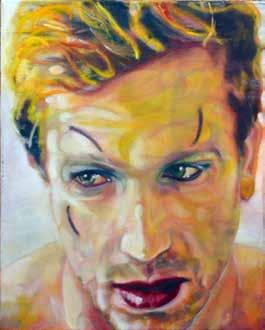
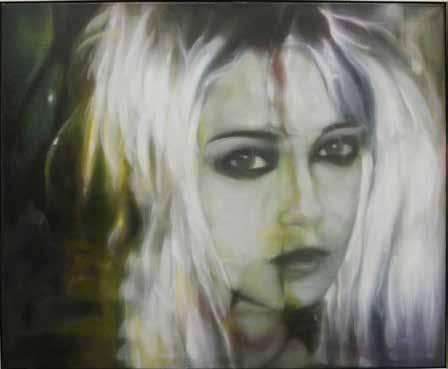

JAMES BELLANEY
Studied at Dunedin school of art graduating 2011. Majoring in painting. A Dunedin based artist has been exhibiting a range of styles the last few years around New Zealand. Taking time off from painting to pursue his inter est in electronic sound and music.
This painting is inspired by journeys I have made through New Zealand, and the relationship I have to this land as a form of expression of my own emotional state at that time. In this work I am interested in the lack of romance in a dirty river stirred by a storm.
Nothing about this show in remembrance of two very missed, eccentric friends should be too “normal”.
Let it Flow Down River 84.1cm x 118.9cm
Acrylic on paper
15
2022
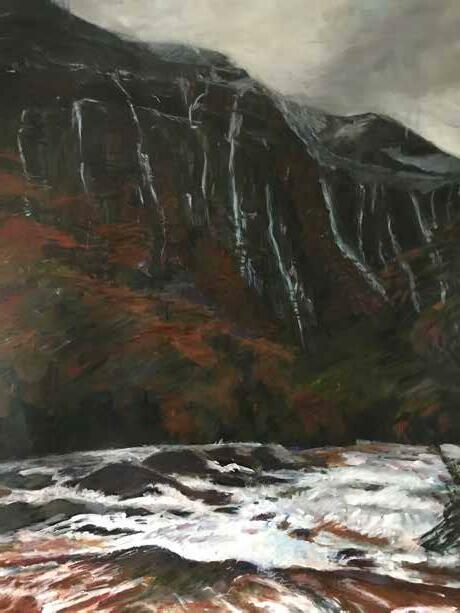
EMMA CHALMERS
Emma is an artist and picture framer who currently lives in Auckland. Prior to this, she lived in Dunedin from 2006 – 2016 and during this time she completed a Bachelor of Fine Arts at the Dunedin School of Art with a major in painting. Following her studies, she rented a small studio in Allbell Chambers where she painted before moving to Auckland to start a Master of Fine Art at Elam which she completed in 2019. Emma’s work is playful and often explores the intersection of gender, power and place in imaginative and subtle imagery. She works in gouache, utilising its delicate, chalky qualities to render subjects – both real and imagined – onto large sheets of empty paper for the viewer to ponder and contextualise in their own time and place.
Dog Mother Gouache on Paper 25cm x 25cm
17
2009

ELIOT COATES
Eliot Coates was born in Ōtautahi, Christchurch in 1984 and currently resides in Ōtepoti, Dunedin. His works embody a meditative and otherworldly space, an immersive dreamscape that coaxes the viewer into quiet contemplation. In a loud and distracting world, the play of colour and light in Coates’ oil paintings encourages us to slow down, focus and be present, in a going beyond words and daily concerns.
Coates is self-taught and currently represented by Gallery De Novo in Dunedin.
Cadmium and Lime Oil on aluminium 33cm x 39 cm
19
2021

LINDA COOK
Having spent three years living in Te Tai Tokerau, Linda Cook moved to Otepoti in July 2020. This enabled Cook to continue her Master of Fine Arts study on site at Dunedin School of Art. As a painter who sees engagement with materials as fundamental to practice, Cook values the hands-on connection encouraged at DSA.
Living near the ocean in St Kilda, the powerful presence of the sea and rugged coastline are a constant reminder of the fragility of life, time, and place. These factors, and the dramatic landscape surrounding Ōtepoti, feed into the subconscious and influence the works.
A Sticky Matter – My studio methodology centres on experiential practice; my making being centred on the relationship I have with materials. By prioritizing the value of material, agency is assigned to matter. I look to the matter to inform the work and acknowledge the materials have sufficient presence to affect sensation and response, both in the making and latterly the viewing.
By blending clays and fillers onto a flat surface, a relationship begins as mind and matter coalesce and I begin to see the material affect within the pictorial field. In this familiar work-zone flowtime occurs, dualism is dispensed with, and a singular mode of operating emerges, moving us to a place which Gregory Minissale refers to as mind-wandering1 a place where “rhythmic connections between abstract art and abstract thought”2 merge. Henri Bergson refers to this as a place of “… ’pure perception’… the mind without memory is really part of the same matter.
1 Minissale, Gregory. 2021. Rhythm in Art and Psychology and New Materialism. Cambridge University Press. UK. p.12
2 Minissale, Gregory. ibid p.12
A Sticky Matter
Mixed media and paint 40cm x 70cm
21
2022
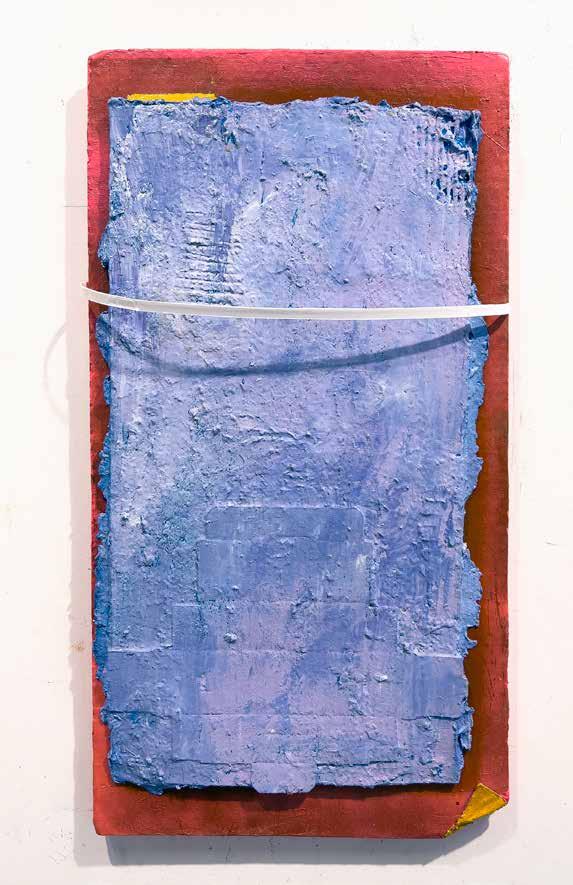
JIMMY VARGA
I’m an Ōtepoti-based artist of mixed Filipino and Pākehā descent. I’ve contributed to Dunedin’s Battle Magazine and have previously exhibited at Wave. This July, I enrolled at the Dunedin School of Art and have been studying under Michael Greaves, Graham Fletcher and Anita DeSoto.
In my current projects, I range between abstract and figurative modes of expression and have recently begun experimenting with larger scale. I am interested in iconographic painting, the high/low divide in art, and notions of cultural nationalism. I engage with these concepts and areas of practice from the perspective of my own disjunctive sense of cultural identity and qualified sense of citizenship.
Place and placelessness are recurrent themes in my work; as are the function (or failings?) of ontologies; and the frangibility of subjectivities which privilege individualism and purport to be unified, autonomous and immutable.
Categorical Proposition Acrylic on canvas 76cm x 60cm
23
2022

Returning to Dunedin from Melbourne after a decade of travel, and missing the experience of exploration and creativity that I had found in travel photography.
I am an Abstract painter-sculptor working primarily with paint on canvas. I also employ clay and other materials as secondary media to bring depth and form to my pieces.
Technically, I work to create texture as a key feature of my work. I draw on Modernist, Minimalist and Abstract Expressionist inspiration and am influenced by some of the classic experimentalists in these modes, including Mark Rothko, Yves Klein, Jackson Pollock, more figurative artists such as Joan Miró and Francis Bacon and conceptual artists such as Anish Kapoor. My practice is intentionally experimental, always trying to find new ways to capture the emotion, visceral reaction or real object I am focusing on, using texture and colour over form. At times I recreate the colour and decay of the buildings and facades of India and the Middle East that I have experienced on my travels or make abstractions of individual photographs.
My canvases show the change over time of the medium as it is layered. I enjoy the Japanese concept of wabi-sabi, which can be understood as finding beauty in imperfection and impermanence.
Liken
Acrylic, kaolin and silica sand 40.64cm x 50.8cm
25 JON COX
2022


Opposite. Gallery installation shot
SAM FOLEY
1995-1998, Bachelor of Fine Art, Otago School of Art, Dunedin
From New Zealand, Sam Foley exhibits internationally, with works placed in a number of public and private collections. From 2007 to 2018 he was a regular visitor to Europe, basing himself between Dunedin and Berlin, exhibiting throughout Europe and Scandinavia. In 2013 he was the recipient of the Kaipara Foundation Wallace Arts Trust Award which included a 4 month residency at the cultural centre Altes Spital in Solothurn Switzerland. Currently, he is happily ensconced with his family up in Glenleith, back in his home city of Dunedin.
The title of the exhibition, ‘Last Light in the Garden’ refers to the mythological expulsion of Adam and Eve from the Garden of Eden. It’s also a meditation on my feelings of anxiety relating to the climate crisis.
Wherever you look across all forms of media, it appears we are facing the very real threat of compounding species extinction, and therefore, the looming expulsion of the human race from Planet Earth. ‘Last Light’ meaning ‘Last Chance to fix the problems we all face’. A sombre topic, yes. I hope the works are beautiful but not without an undercurrent of apprehension, of the immovable weighted shadow.
And anyway, who’s to say that the end of the world wouldn’t be a beautiful cataclysm?
Last Light Study III Acrylic on canvas paper 37.5cm x 27.5cm
29
2021

MICHAEL GREAVES
My studio practice has always made reference to time in painting. Time of making, time of viewing, a condensation of both. I feel like the painting is a record of multiple moments, and thoughts that run parallel to the process of considered studio work. I like what Alan Smith said in a recent catalogue essay accompanying the exhibition ‘Necessary Distraction: A Painting Show’ (Auckland Art Gallery Toi O Tamaki, 2016) that, “Painting has always occupied a space between the material and the idea, the sensible and the immaterial…(that) a Painting is like a membrane, access-panel, hinge, skylight, fairy fabric, and dream screen…here and elsewhere.” This notion of here and elsewhere speaks to me in the act of painting, of mis-remembering a thing or object of the world which forces you to shift toward a reliance on sensation and experience to image or imagine the painting. Elsewhere is now not an unknown place for the painter. Access to almost everything is at the touch of a screen, and I like to actively disrupt this, accumulating layer upon layer of paint onto the surface to realise, and access the feeling and sensation of what I am aiming for in paint. This work, ‘Sullivans Second Cloud Book’, draws its attention towards a fictional character and their collection of objects in their world. For Sullivan there is an escape into an imagined world of everything in books, and how books can activate this imagination in unresolved ways. This work is part of a broader series to be shown at Five Walls in Melbourne in November of 2022, and again at Melanie Roger in Auckland in early 2023.
Michael Greaves is Principal Lecturer at the Dunedin School of Art. He holds Degrees in both Art History and Education as well a Masters in Fine Arts in painting (Distinction). He has works in several public and private collections here in New Zealand, and is represented in multiple private collections in Australia, the UK, Europe and America.
Sullivans Second Cloud Book Pigment and oil on canvas 40cm x 50cm
31
2022
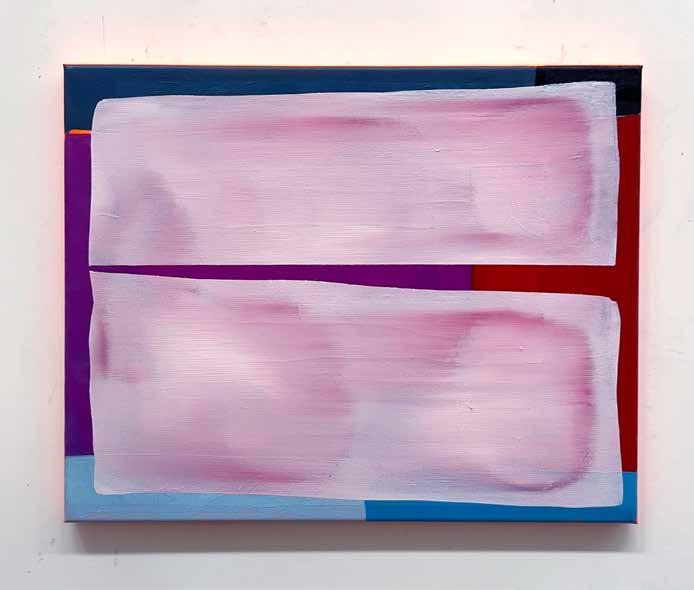
NICOLA HANSBY
Nicola Hansby is a painter living in Ōtepoti, Dunedin, having studied at the DSA from 2002 – 2006.
Arranging still life of inanimate objects in her studio, she crops and simplifies subjects, trimming away until only essential elements remain. In doing so she explores the interplay of shape, form and negative space.
‘Jessie’s Gravy Jug’ is a work composed of colour rather than line. A jug of cut flowers is depicted side on against a field of sensuous, all-enveloping red. Hansby sheds light on the inspiration for this particular work:
“Last year my three-year-old niece told me that her three favourite things were sparkles, the colour pink and gravy. She was very serious but it was so funny. The gravy jug belonged to my late Grandmother and I like to paint it because it’s unusually low and long.”
Hansby has exhibited nationwide including “Laissez Faire” at the Jonathan Smart Gallery in Christchurch and the NZ Academy of Fine Arts, “Parkin Drawing Prize Finalist Exhibition”, Wellington. Hansby’s work titled “Ampa, Used Fireworks and Other Objects” received a HighlyCommended Award in the 2014 Parkin Drawing Prize.
Hansby has also organised and curated a number of community minded art projects and events. Most recently she organised and curated “Exquisite Corpse”, a collaborative drawing project involving a total of 63 artists. The collaboration produced 21 drawings which were exhibited at Olga Gallery as part of the 2021 Dunedin Fringe Festival. This raised $3000 for the charity Chat Bus, a children’s counselling service.
Jessie’s Gravy Jug Acrylic on Canvas 50cm x 50cm
33
2021

HANNAH JOYNT
Attended Dunedin School of Art : BFA 2003 - 2006, MFA 2015 - 2017
Hannah Joynt is a contemporary visual artist who works in a range of media, processes, and scales. From digital illustration to oil painting, pastel drawing to laser cutting her practice is often informed by the absurdity that can be found in our relationships with landscape and the natural world.
She also works in a collaborative artist duo with multimedia artist and musician Jane Venis. Their collaboration includes live performances of drawing and music created in dual improvisation and performance art video works under the collective name Small Measures. In 2019 they undertook the Buinho Creative Art residency in Portugal and recent solo shows include: Drawn to Sound at Ashburton Art Gallery in 2019, Dual at CICA (Czong Institute of Contemporary Art) Museum in Seoul, South Korea in 2020 and in June 2021 their five-minute film Flag Plant was recently screen as a part of the Bomb Factory Artist Film Festival in London.
Hannah is also a senior lecturer in the College of Creative Practice and Enterprise at Otago Polytechnic. In 2021 she was recipient of the Ako Aotearoa Award for Sustained Excellence in Tertiary Teaching.
The Annual Event Oil on board
x 60
35
60
cm 2022
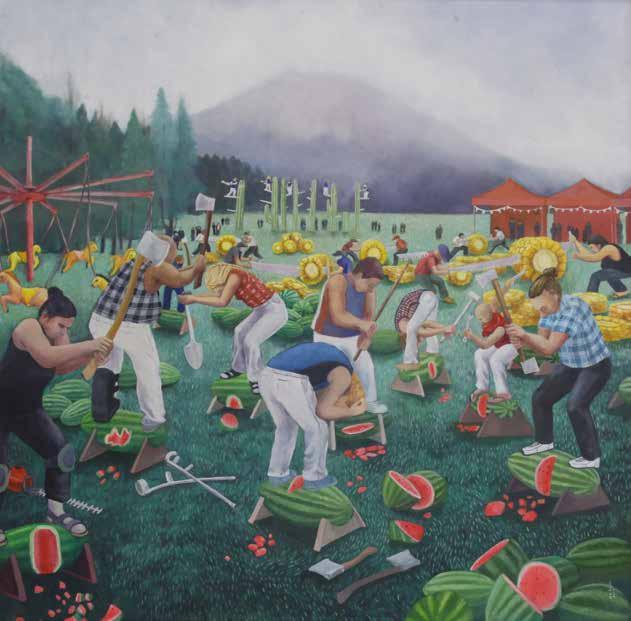
SYLVIE KAOS
Currently Masters student - Master of Fine Arts, Dunedin School of Art, New Zealand
Shapeshifter: Metamorphosis
My current studio work has produced a disparate array of images, with an ambiguous connection between materials and subjects. The connection is the vital materiality and liveliness of objects – the call of objects and the hold they have on people. If we deliberately bracket off the agency of humans in the creation of a hoard, in the obtaining of objects, then how much agency do those objects utilise in the obtaining of us?
In a capitalist world that relies on and demands our participation in production and dispersion and consumption, and being an animal that was never designed to cope with the sheer number of objects we as a species currently produce, to what extent do those same objects swarm and flock to create their own spaces. Do they gather and congregate and push us around? There is a hoard of theorists enmeshed in this creative process, and a hoard of ideas, concepts, and theories. In fact, hoarding is an ideal focal point for expression of vital materiality and the collaging of fragments and detritus.
I am interested in what abstract value masses do throughout an image, how assemblages work, and the effect of signifiers from other authors. My experimentation is research into the loading of objects, representational manifestation, and the unmasking nature of cut ups. Collage is the perfect medium for exploring assemblage, and how a collective of disparate elements becomes an entity.
Above right Here for now (thinking) paper collage on board 29cm x 60cm
Below right
Just in case (thinking) Paper collage on aluminium 28.5cm x 40.8cm
37
2022
2022
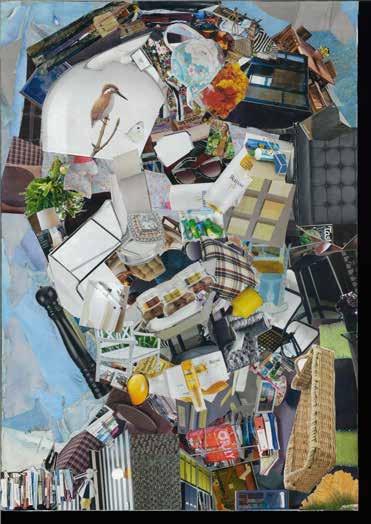

Philip Madill graduated with a Bachelor of Fine Arts from the Dunedin School of Art in 2009 and is represented by Olga Gallery in Dunedin. He also holds a bachelor’s degree in history from the University of Otago (2005). In 2014 he completed a Master of Fine Arts with Distinction, in which he worked primarily in drawing.
Madill’s work examines the historic proliferation of virtual technology and its impact on the role of drawing as a form of mediation. He creates immersive dystopian landscapes that are littered with defunct machinery to emphasis the dehumanising and hybrid nature of the virtual world. He is currently working towards a Doctor of Philosophy in Art and Design at the Auckland University of Technology.
Unreal Estate Pastel on paper 35cm x 65cm
39 PHILIP MADILL
2022
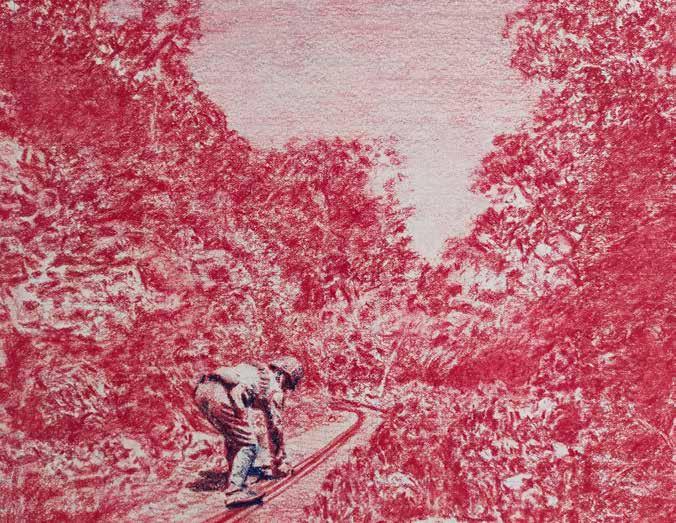
PIPPI MILLER
Pippi Miller is a painter, writer, and illustrator who lives in Dunedin. She is currently in the last few months of her MFA at the Dunedin School of Art, and has also been a student of literature at Otago University. Pippi Miller has exhibited works in two group shows at RDS in 2020 and 2022, and looks forward to continuing to explore her practice as an artist in Dunedin after graduation.
Torea Oil on canvas 28.5cm x 41.5cm
41
2022
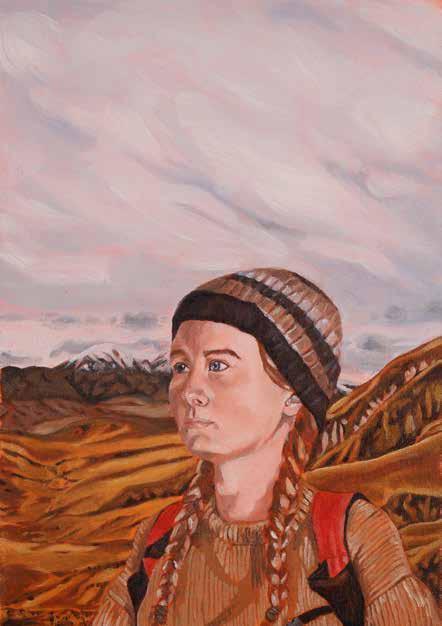
CHARLOTTE ROBERTSON
Charlotte Robertson is a painter based in Ōtepoti. Her artistic practice sits alongside her work as a healer where she visits non ordinary reality and the unconscious realms, receives visions and concepts and seeks to translate these into visual portals.
Robertson’s ephemeral, dreamlike paintings carry layered meaning and narratives where personal and collective mythology are explored. Her work is predominantly oil painting on timber and ink on paper.
The enclave, the beginning 42.5cm x 42.5cm Oil on ply, framed with recycled Siberian Larch
43
2022
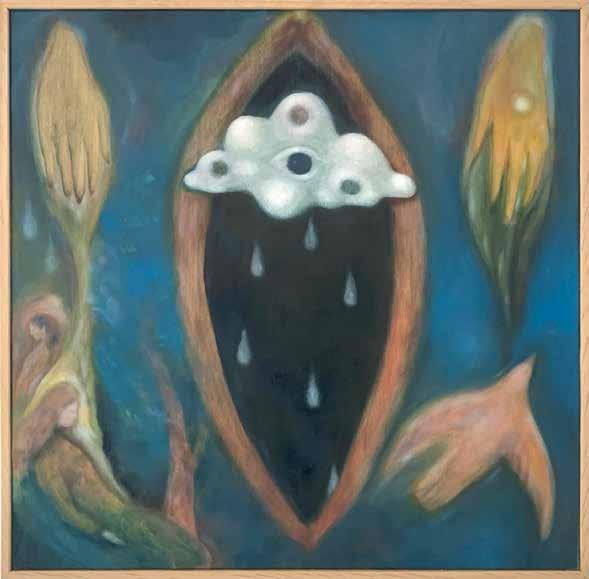
Anya Sinclair (b1978) grew up in bush clad Laingholm, Tāmaki Makaurau. She started her BFA at Elam, completing it at the Dunedin School of Art after relocating to Ōtepoti Dunedin in 2005. Anya is painter predominantly focussed on landscapes pre or post human. Solo shows include ‘The garden of forking paths’ at Tauranga Art Gallery and ‘Forest lives’ at Ashburton Gallery. Recently, as a response to the anxiety of Covid lockdowns, and of climate change, Anya has made hundreds of ‘single session’ paintings of flowers.
I saw DANNY’s painting before I met him. When I first spent time with him, we played Polka at a friends house in North East Valley. He wore an open pink shirt, tight white T-shirt and a gold chain. He laughed a lot. I couldn’t match him to his painting.
The painting i knew well, because it is incredible; a gnarly old man, hung at Al Bar in Dunedin. Danny’s ability to imbue rich character in his portraits was unrivalled in our painting community. And like Flynn, he often used seductive devices to convey darker themes. Disarming colours, soft pinks, bold reds, dreamlike floating imagery.
FLYNN and I both worked as dishys at Plato. Occasionally I would bump into him in the street in Dunedin. He wouldn’t hesitate to begin a conversation about painting.
I think about his work now and see how often he presented melancholy and horror through an aesthetically pleasing mask. In my own work I consistently play with this device. I miss our conversations.
I watched his funeral from my bedroom in Port Chalmers. A Purple Pilgrims song was played: Delphiniums in Harmony, Two Worlds Away. It seemed to me to beautifully capture Flynn’s lust for life and the sadness I felt at the loss of him.
I wanted to paint a big pink painting for Danny, for Flynn. It turned out to be mauve. But the message is there. Beauty and death are intertwined.
Acrylic on unstretched canvas
45 ANYA SINCLAIR
no. 433
134cm x 125cm 2022
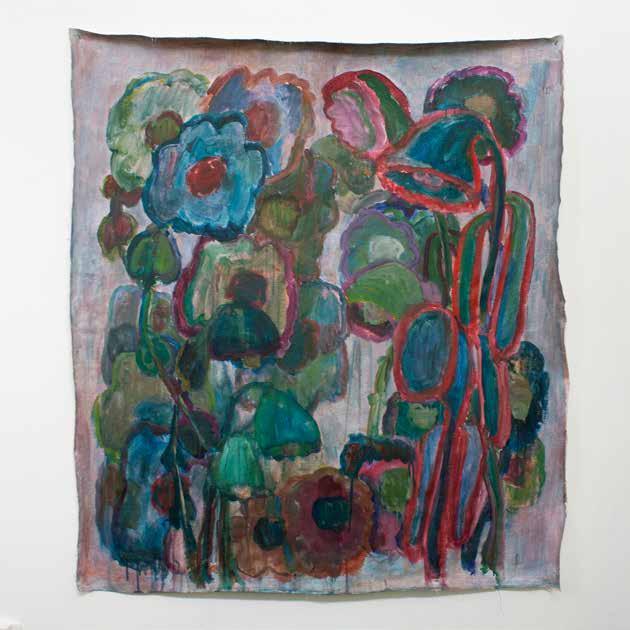
PETE WHEELER
Pete Wheeler (b.1978) holds a BFA from The Dunedin School of Art (2000), and a MFA from the University Of Canterbury (2009). He currently lives and works in Dunedin with his wife and three children. Pete has held solo shows in New Zealand, Australia, America and Europe. He has multiple works in the James Wallace Collection, Otago University, Lincoln University, the Jan Warburton Arts Trust, the Eleen Kaminsky family foundation (New York), the Zabludowicz Collection (London) and the Martin Sosnoff Collection (New York).
Pete has spent the last 14 years living and working between Berlin and New Zealand as a full time artist. His paintings, often grand in scale and subject, explore history, popular culture, and ongoing pressing concerns that interlace the idea of artist as maker, and as husband, father, friend and citizen. Mixing the high and the low, Wheeler comes from a conscious position, a product of his international urbanity and his small town New Zealand upbringing. His language is clear and necessary, both in his painting and in his daily practice.
Oil and oil stick on canvas 75cm x 75cm (framed)
47
Hooter
2022

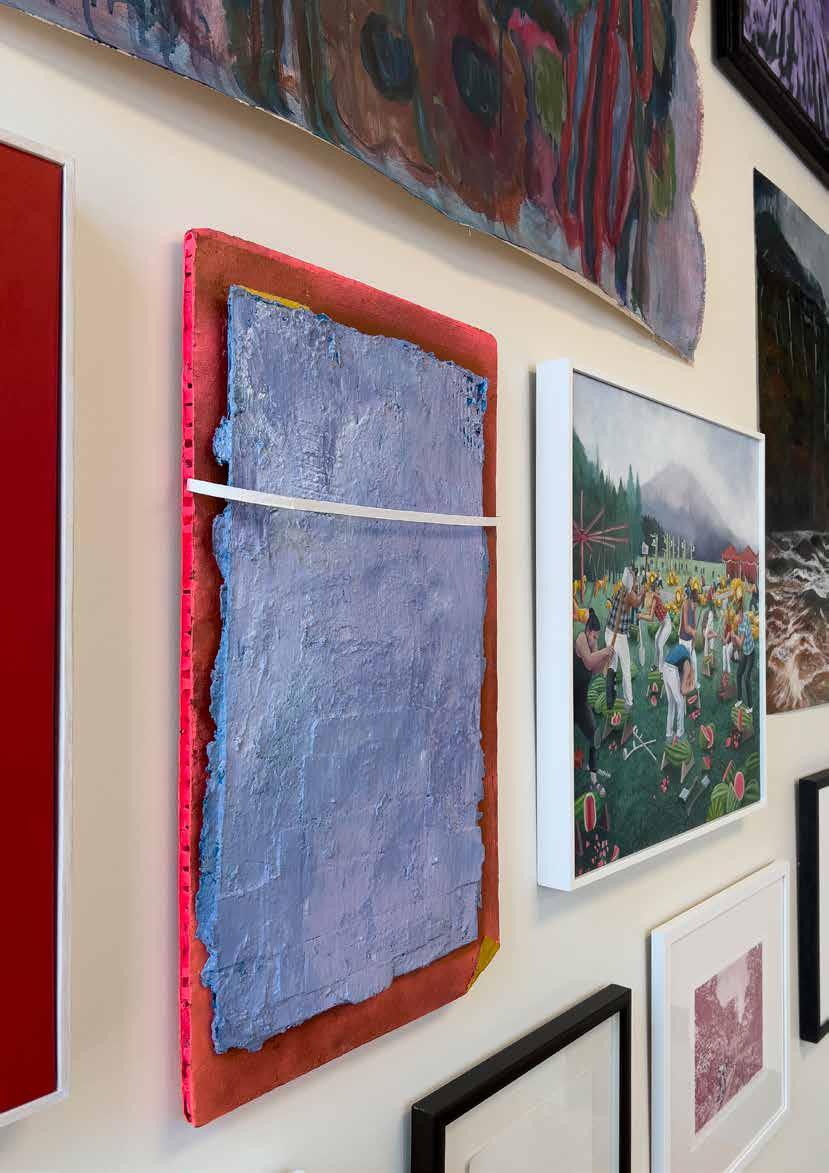
Opposite. Gallery installation shot
NEW DUNEDIN PAINTING (redux)
Foreword by Professior Leoni Schmidt Essay by Edward Hanfling
Published by Otago Polytechnic Publications on the occasion of the exhibition NEW DUNEDIN PAINTING (redux) Wave Project Space. 1 Vogel Street, Ōtepoti, Dunedin. Director: Kari Schmidt Curators: Kari Schmidt and Michael Greaves
Published in New Zealand by: Otago Polytechnic Publications Forth Street Dunedin 9016 www.op.ac.nz
Otago Polytechnic Ltd is a subsidiary of Te Pūkenga - New Zealand Institute of Skills and Technology.
© 2022 Wave Projects
© 2022 Contributing artists and writers
All rights reserved. No part of this publication may be used except in accordance with the provisions of the Copyright Act 1994 or with the written permission of the authors.
The Director of Wave Projects and Curators gratefully acknowledge the publishers, institutions and individuals referenced in the document for their contributions
First published 2022
An online version of this publication is available free at https://online.op.ac.nz/industry-and-research/research/epublications/e-books
ISBN 978-0-908846-80-1 (Online)
DOI https://doi.org/10.34074/cata.221001
Copyediting: Kari Schmidt Design and typesetting: Michael Greaves


WWW































